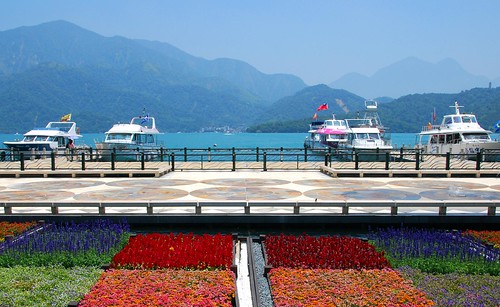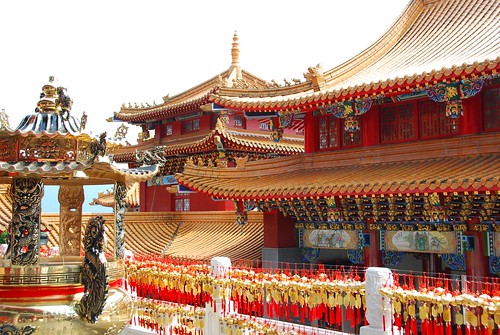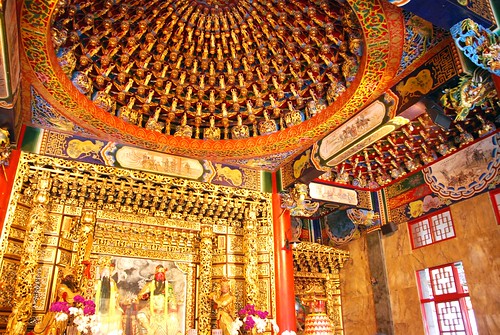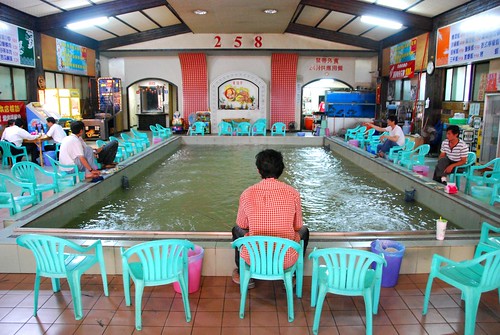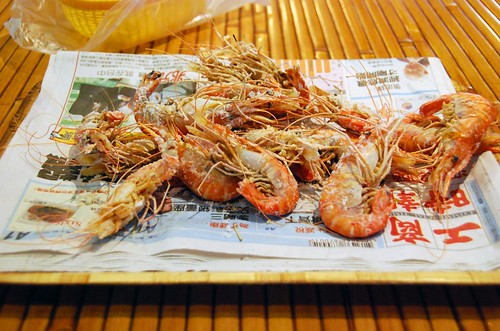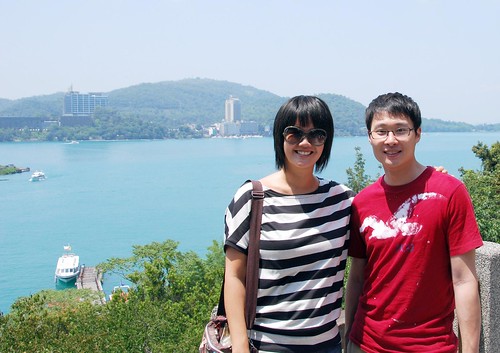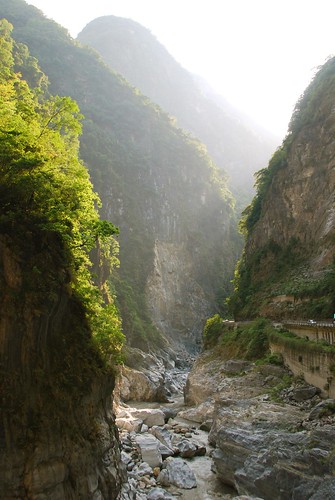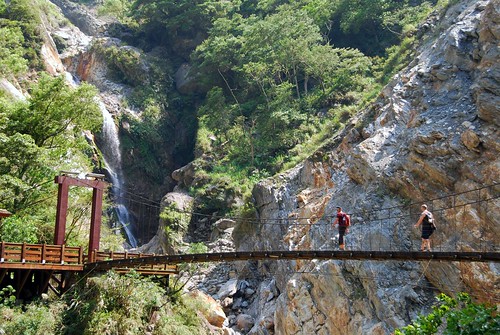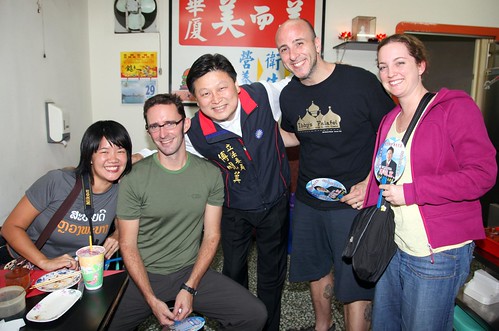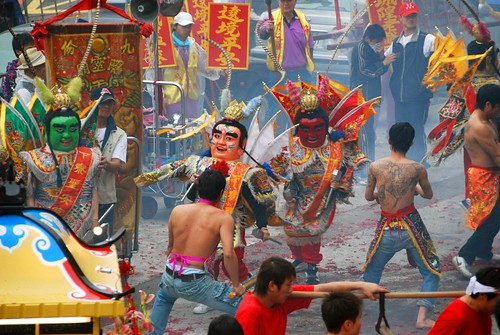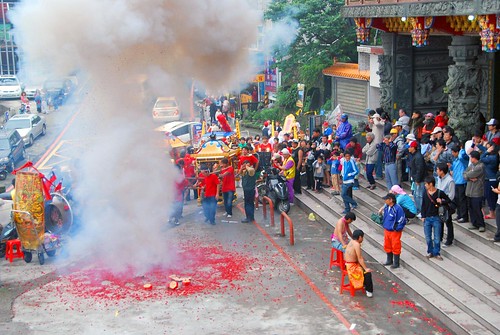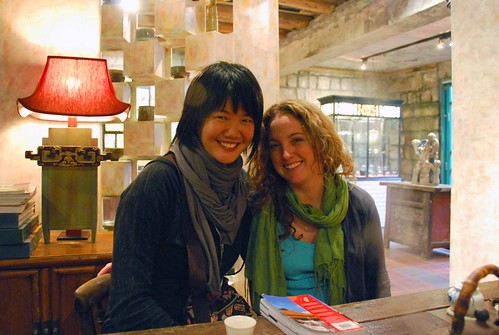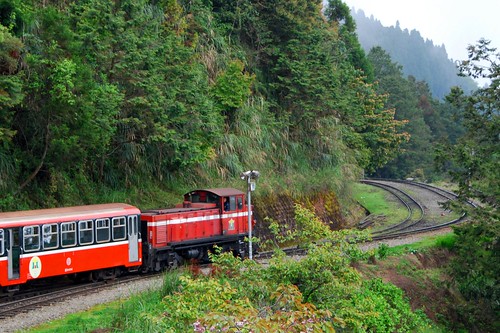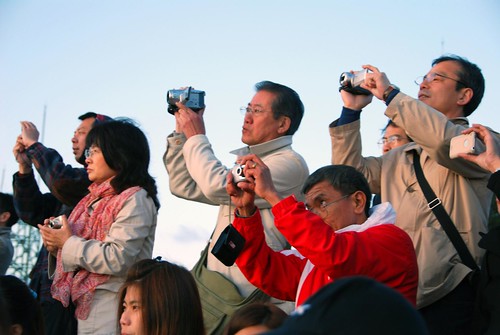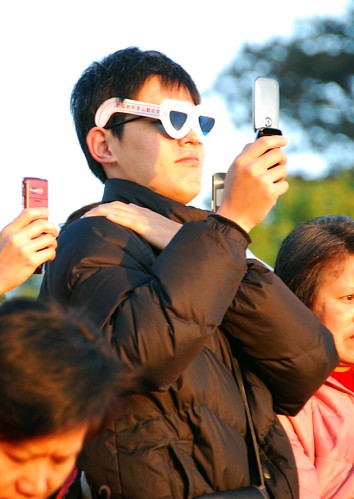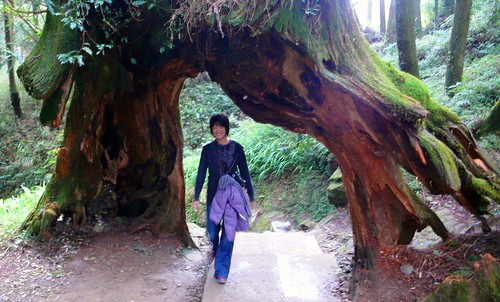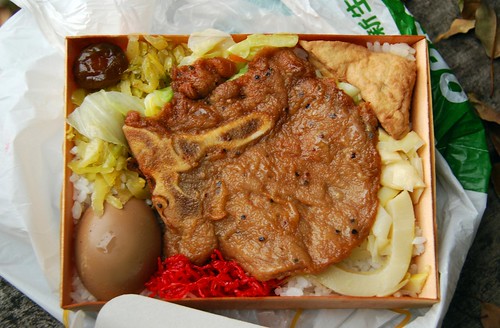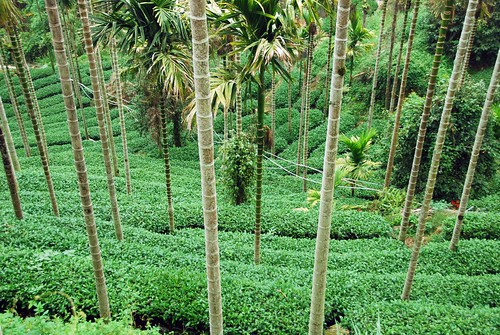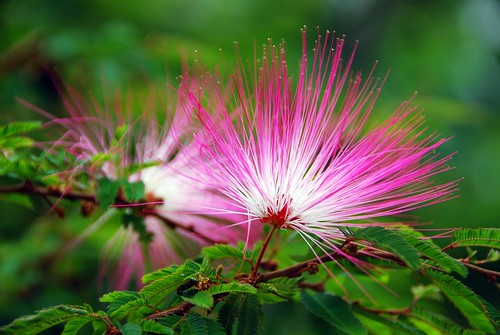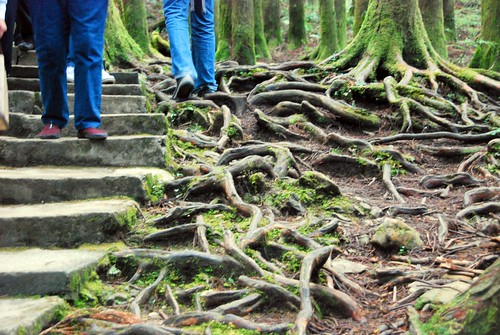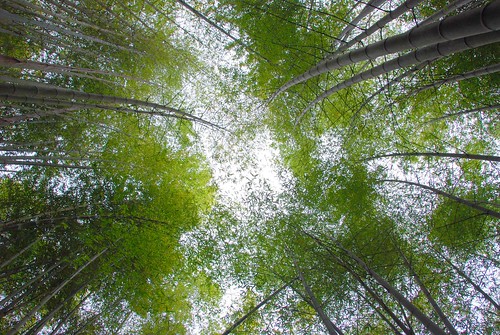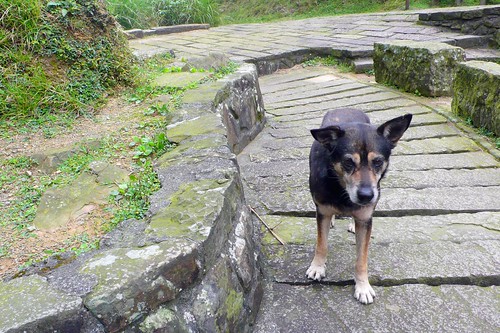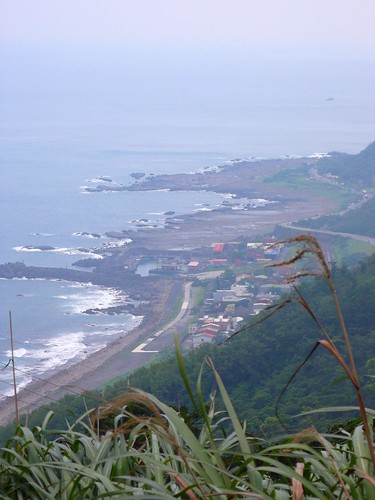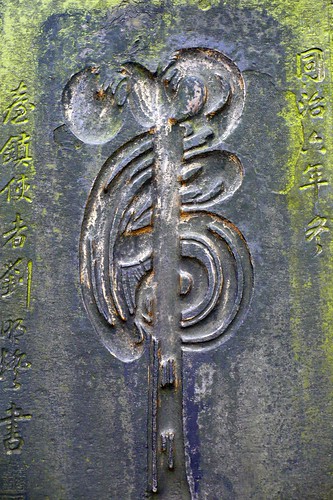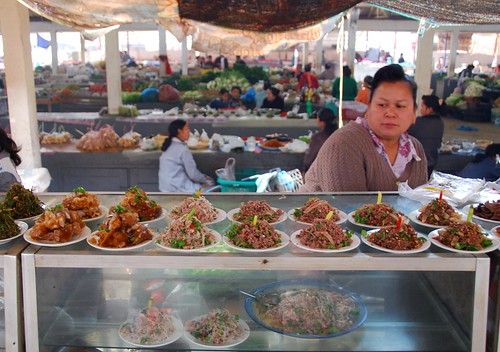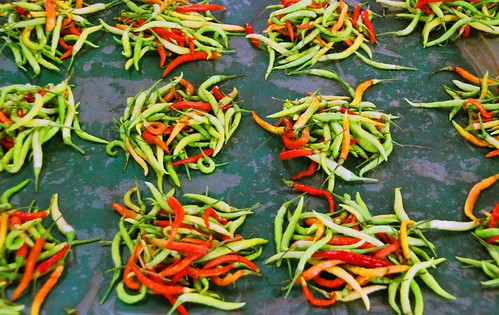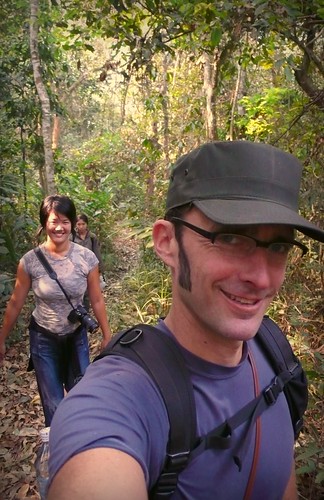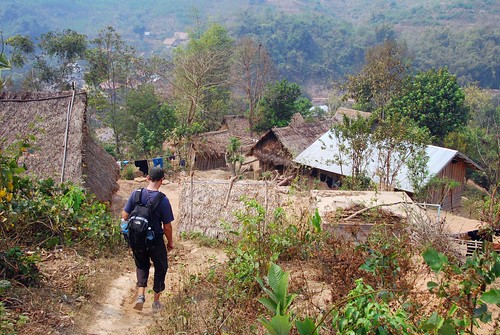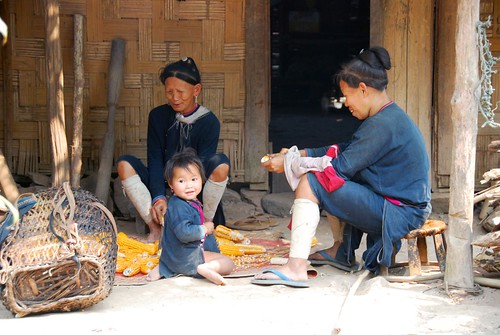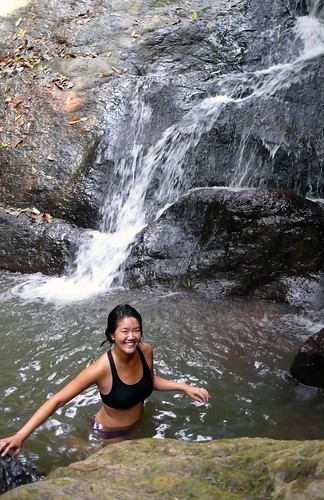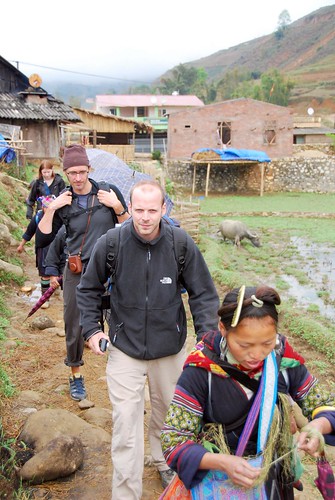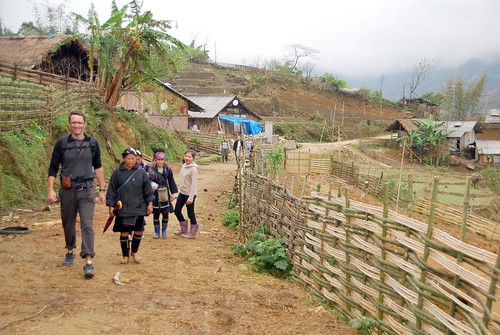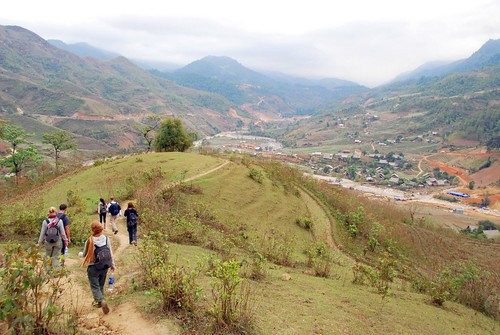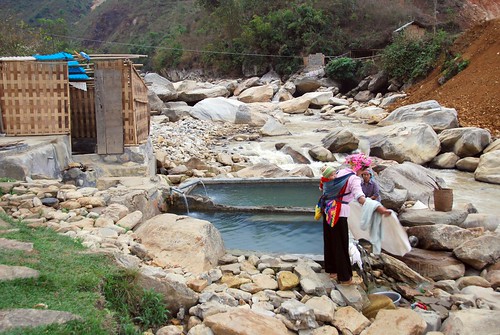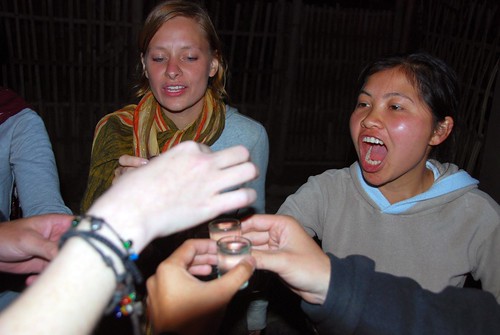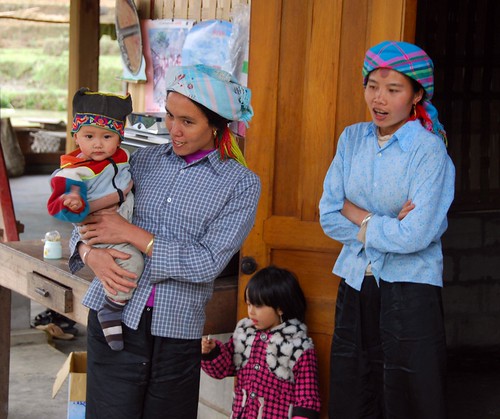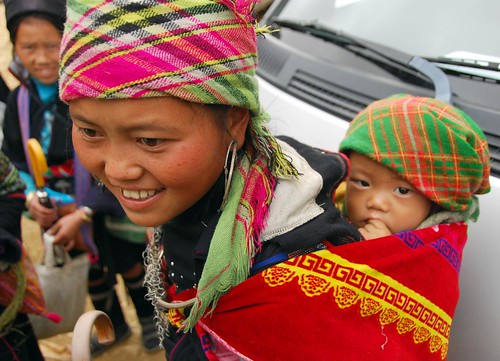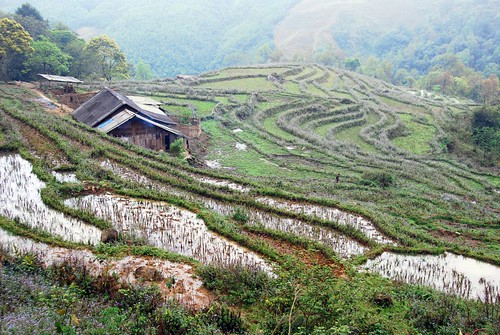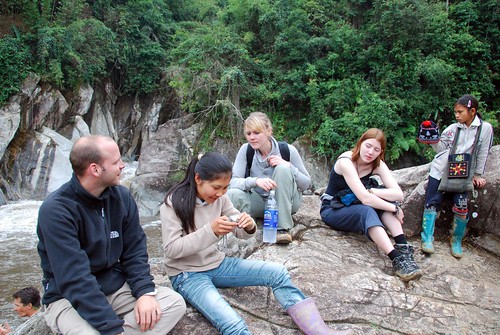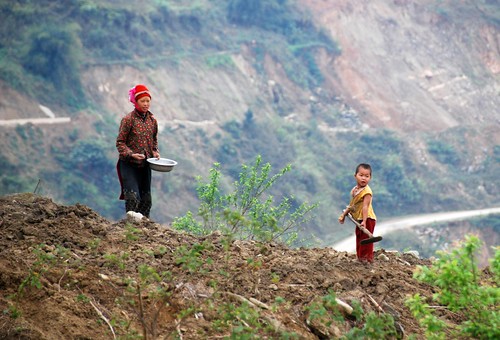Posts Tagged ‘blogsherpa’
Note: Hey everyone, let’s give a warm welcome to Eddo! My little bro shares his thoughts as the family travels Huangshan…I love that even though this post is about a mountain, he manages to nerd out on urban planning. Kudos, Eddo! ![]()
As an urban planning nerd/activist, I’ve always been interested in the growth and history of cities. Why did this particularly scenic peninsula morph into modern-day San Francisco? How did the end of the Mississippi River support a multi-ethnic creole population like New Orleans? How did two tiny islands in the middle of the Seine River become a focal point for a global city? How did civilization in the past evolve into its current form, and how do our actions today determine tomorrow’s society?
Anyways, enough of this urban speculation—I promise I’ll get back to it later—let’s get to the heart of this entry. Huangshan (in English, “Yellow Mountain”) is located in the Anhui province of China, and is a major mountain range which has been opened up for tourism. It has inspired countless Chinese poems, literature, and paintings, and deservedly so, because it is one of the most scenic and beautiful places I’ve ever personally experienced.
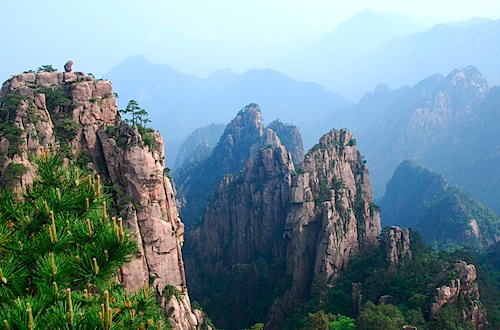
Monkey Rock (the little rock perched on top of the huge stone on the left) overlooking the Valley.
I’ve never been to China before, let alone Huangshan. The last time I was remotely close to China was probably when I was 6 or 7 years old, and was in Taiwan for my Da Jo Jo’s and Da Jo Ma’s wedding. I don’t really recall much from that time, except I liked riding on my youngest uncle’s motorcycle/scooter, and that it was really hot. So for me, Huangshan was not only an eye-opening experience, but also my introduction to China.
China’s problems with rapid modernization and urbanization are well-documented, and I don’t think I need to go into too much detail, but to be introduced to China via its rural and agricultural communities, is, in a word, refreshing. We in America like to glorify a simpler time—when seasonality and locality weren’t just buzzwords for haute cuisine, when communities and societies flourished not because of economic indicators like GDP and inflation rates, but instead on the reliance of individuals in each community to provide a good or service necessary to its citizens. And this is what China is about, I think. Despite its rapid modernization, at the core of all production is people—roads are created by people moving around rocks in wheelbarrows, crops are planted by people leading water buffalo through a field. The concept of labor here is unlike America, where machines have taken over the most difficult of tasks. If there is a resource that China has utilized more so than any other country, it is its people. Performances like the Beijing Olympics Opening Ceremony requiring massive amounts of people, control, coordination, planning, and creative vision, could not have happened anywhere else in the world. Of course, this is both a positive and negative—things are built or created at a frenetic place, but the value of human labor is less than in other countries and services rendered by humans cost exponentially less than anywhere in the West. People are valued less as specialized individuals as they are cogs in a well-oiled economic machine.
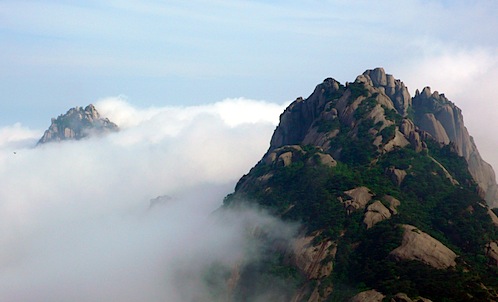
Huangshan’s famous “cloud ocean.” It literally moves in and out in minutes.
Walking through Huangshan is a series of stone steps and pathways meandering along streams, cliffs, forests, and valleys. It is stunning. But you do get a sense of devaluation of individual labor. Couriers or porters carry up all goods that are used by the hotels at the top of the mountains (Ed. note: Indeed, supplies are not allowed to be hauled up the mountain on the gondola—even though it is surely cheaper to mechanize the delivery of these goods—in order to create jobs for local farmers who otherwise wouldn’t be able to earn a decent wage), luggage from tourists, and in some cases, people who cannot walk up or down the grueling paths of the mountain. It is incredible—I can’t imagine the amount energy or labor involved. They get paid by the kilo, and generally balance inhuman amount of goods on a single bamboo stick on their back. Our tour guide told us that they can make up to 1,000 RMB a month (around US$150) which is actually a decent salary in their area. Individuals who work in the hotels on the top of the mountain stay up there for three months at a time, and get free room/board while earning salary.
I don’t know how old the trails and steps of Huangshan are, but one does get a sense of how civilization and societies emerged in the olden days. Locations were picked based on geographic resources, and paths were then created to connect major population centers with each other. Much like cities in America developed along the Mississippi River from Chicago down to New Orleans due to geography and natural resources, I imagine this is how “cities” developed in Huangshan. Except in Huangshan, these “cities” are essentially outdoor plazas with hotels and restaurants, instead of actual cities. But these gathering places and webbed network of paths towards peaks and valleys and sights are in a sense, a microcosm of China, where cities are connected to each other by a network made up of boats, rail, roads, and planes rather than stone steps.
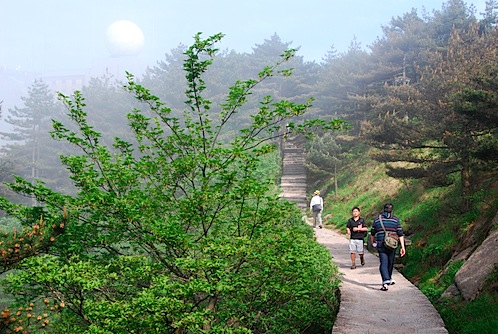
Eddo hiking towards the giant golf ball (on the left, in the background), a weather station located at Huangshan’s highest point.
Huangshan, much like the rest of China, encompasses a scale that I can barely comprehend. It is stunning. It is dramatic. It is imposing and it is spectacular. It is filled with jagged peaks, intense sunrises (which we woke at 4:30 for, climbed up a mountain and after concluding we wouldn’t see it, started hiking back down the mountain, only to see the sun peak through the trees, d’oh!), and ancient trees and wildlife. The Chinese have a saying that Huangshan is number one—after experiencing Huangshan, you need not experience any other mountains. My mother, who was also experiencing China for the very first time (she was born in Taiwan and because of China’s irregular rules on tourism during the Mao era, she hasn’t been able to visit until China became more open in the years after Mao’s death and China’s embrace of capitalism) celebrated her birthday on top of Huangshan. She said “I had always heard of Huangshan ever since I was a little girl but was never able to experience it firsthand until now. I cannot believe that I am celebrating my birthday here. I am so happy.” I think we’d all agree—there is no experience like Huangshan in the world, and despite what you may think about China politically, Huangshan is not just a Chinese treasure, but a treasure for the world.
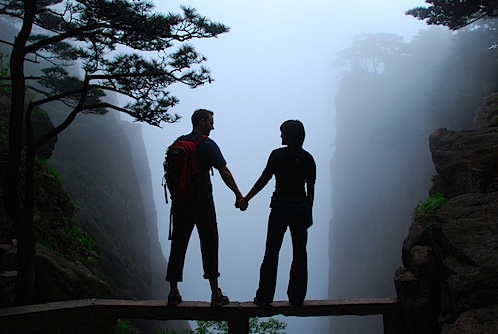
P.S. Here is a link to Eddo’s photos of Huangshan on his Facebook.
For 2 years prior to leaving on this trip, I worked at an awesome design studio called NOON in San Francisco. A few years back, a guy named Allen joined our little family as a freelancer for a few months before returning to Taiwan to do his required military service (he is a Taiwan citizen). Allen and I also went to art school together at CCA, but he was a semester ahead of me, so I didn’t really get to know him until we were coworkers.
Lunchtime (and food in general) is a really big deal at NOON, so I was sure to call Allen as soon as we got to Taiwan, because I knew he would know where the really good food was. ![]() We didn’t end up getting together until our last weekend in Taiwan, but we definitely made up for lost time!
We didn’t end up getting together until our last weekend in Taiwan, but we definitely made up for lost time!
Allen lives in Taichung, the third largest city in Taiwan after Taipei and Kaohsiung. It’s in western Taiwan, an area we hadn’t traveled to at all, so we boarded a train to Taichung and got there just in time to hit the night markets with Allen.
Now, before we get into all the crazy stuff we ate, let me explain the night markets in Taiwan: they are amazing! It’s literally fun for the whole family, and vendors sell everything from false eyelashes to cheap t-shirts with bad Engrish grammar. But the best part of the night market is the food. Typically, you go from stall to stall trying out all the strange and exotic treats on display; it is not unusual to eat about 10 different snacks in one trip.
In Taipei, the night markets are a little too crowded for our tastes, with wall-to-wall people pushing you through narrow alleys crowded with vendor stalls. So Jeremy and I hadn’t really done the whole “eat-10-different-snacks” thing at the night markets. But with Allen as our guide in Taichung, we finally cut loose! Yes, folks, we ate the infamous stinky tofu!
And it was good! It definitely is not as pungent tasting as it is smelling…and the nice, thick layer of cold pao cai (pickled vegetables) on top adds a nice temperature and texture difference to the deep fried stink. We also ate duck neck and intestines (also REALLY flavorful; the vendor chops the various parts up into little bite-sized bits so you don’t FEEL like you’re eating a duck’s neck):
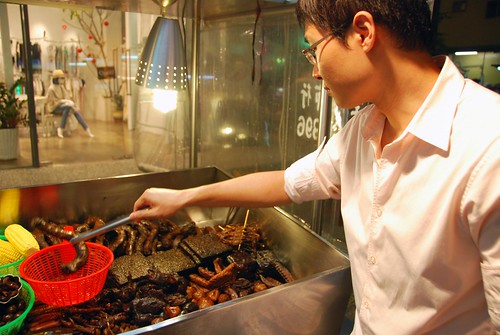
Allen picking out our duck neck and intestines.
We also tried octopus balls (like meatballs, but made out of fish and octopus—not actual octopus balls), a soup with blood and rice cakes, something called mian xian (a thick noodle soup), eggets, delicious popcorn chicken, boba tea with soy milk, and an oyster omelet.
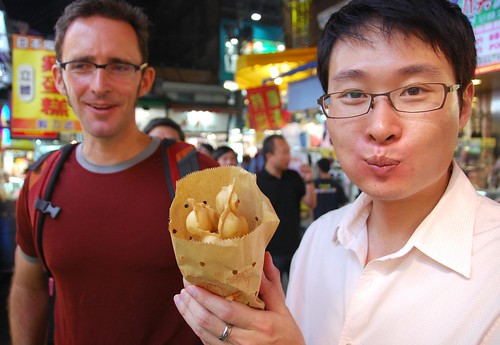
J and Allen enjoying our eggets.
I kept thinking how proud the NOONers would be of us, given all the scary stuff we ate (and also how I wished they could join us)!
The next day, we headed to one of Taiwan’s big tourist attractions, Sun Moon Lake. Allen brought his nice friend Mo along for the ride, and we had a great time chatting with them on our way up to the lake.
Sun Moon Lake isn’t actually that great; it is super commercial and the gorgeous lake scenery is a bit scarred by the development that has gone on around the shore, but it was a beautiful day and we were only there for a few hours, so the commercialism didn’t bother us too much. We took a short cruise around the lake and then drove to a nearby Confucius temple, which was really stunning, both inside and out.
We headed back to Taichung and ate some more…this time, we had mango bao bing (fresh mango and sweetened condensed milk over shaved ice) and duck wings. Afterwards, Allen wanted to take us shrimp fishing. We really had no idea what this meant, and quite frankly, we thought it sounded kind of boring, but we had a couple of hours to kill before we headed back to Taipei on the train, so we figured what the heck…when in Taichung…
It turned out to be surprisingly fun! Basically, you shrimp fish at a restaurant that has a giant kiddie pool in the middle, surrounded by tables. You pay by the hour and upon entry, you are handed a rod, a net, and a hunk of cow liver. You slice up the liver and attach it to your hook…and then you wait until a shrimp bites. And these guys are HUGE, like the size of your hand. Every hour or so, this guy comes out of the back with a bucket of shrimp and throws it in the water, hopefully near your hook. ![]()
Between the four of us, we only ended up catching 3 shrimp in our alloted hour, but luckily you can buy more shrimp by the kilo. There is a broiler right next to the pool, so you bring your catch over there and roast your shrimp up with some salt. Mo goes shrimp fishing 2 or 3 times a week, so knew what he was doing and took charge when cooking our haul. In a few minutes, we ere feasting on our freshly-caught (and bought) shrimp!
We had an awesome 24 hours in Taichung…Allen and Mo took really good care of us and totally pulled the Taiwanese custom of paying for everything behind our back. Allen and Mo, please let us know if you are ever in San Francisco! Hopefully we can return the favor!
Note: We have a special treat for you today! Kara wrote this awesome guest post about the 3-day trip we took to Taroko Gorge. Thanks to K for lending us her voice…and thanks again to K & P for coming out! It means so much to us to share this adventure with you. We love you!!!
If only we could do it all again! Patrick and I would eagerly join Hope and Jeremy on the other side of the globe again to share in a little slice of their adventure. (And I would do it just for the sight of Hope’s hands waving in the air as she ran out to meet us after our cab dropped us off from the airport.) We spent a sparkling 10 days with the Menghermanns in Taiwan, and can wholeheartedly second that: Taiwan is awesome. We discovered new things to impress us and enjoy every day—even stopping in 7-11 to use an ATM was an adventure! (Which makes me empathize with Hope…it’s difficult to write a blog post on one subject when really, there is so much to share!)
In the midst of our Taipei sightseeing and day trips to hot springs and teahouses, the four of us took a three-day jaunt to Taroko Gorge, one of the island’s biggest tourist draws. An 2.5-hour express train south from Taipei Main Station brought us in around noon to Hualien, gateway town to the Gorge. We totally scored with our hotel: the (un-inspiringly named, but inspiringly decorated) No. 6 Homestay (http://hs101.com.tw/index.php). It’s owned and run by a supercute husband and wife team and their sporty retriever, Kuchi (see photo of Kuchi here, complete with polo shirt and adorable buckteeth).

With our Hualien homestay family. You can see Kuchi strolling out of the photo into his doghouse on the right side of the photo. Check the lion cut!
Our homestay family picked us up from the train station (Hope told them to look for the four wai guo ren’s standing in front of the Visitor Info Center! Ed. note: Actually, I said: “I am really tall and I’m with 3 wai guo ren’s. You can’t miss us.”), took our breakfast orders for the next morning, and held onto our bags because our rooms weren’t ready and we were eager to get our hike on. A little back ’splaining: Taiwanese and Chinese, the main tourist population in Taiwan, really like their tour groups and massive buses (Ed. note: I found out later that people from the mainland are actually required to travel Taiwan in tour groups. Guess the Taiwanese are a little worried about Chinese people running around their country no-holds-barred). So there was a lot of pressure to take a tour bus of the Gorge. Really?! Being bull-headed, do-it-on-our-own Americans, we took a cab the 30 minutes into Taroko National Park and our driver dropped us off at the Shakadang trailhead [insert your Chaka Khan reference here].

The boys on Shakadong Trail, Taroko Gorge. The river water is naturally that vivid blue color.
After shakadangin’ an easy, very pretty 3-hour hike along a river, we caught the slow public bus back to Hualien from the park’s visitor center. We’re crediting Patrick with the next brilliant idea: next door to the Hualien train station, we rented two red peppy scooters for NT$400 (approx. US$12) per 24 hours. Awesome! We were able to zip over to a night market area and feast on what ended up being some of the most memorable XLBs of our trip. (According to Hope’s reading, these were Taiwan-style, with a thicker, spongey dumpling exterior, as opposed to the Shanghai-style XLBs we’d been eating in Taipei. They were so good that we felt the need to dine on them BOTH nights in Hualien!) And the next morning, we scooted off happily on our own time schedule to hit some of the main sites and trails in gorge-ous Taroko.
Our drive into the park was thrillingly beautiful…the roads are narrow and curvy and we had the best of both worlds, pulling off often to snap photos and yet zooming around those smelly tour buses.
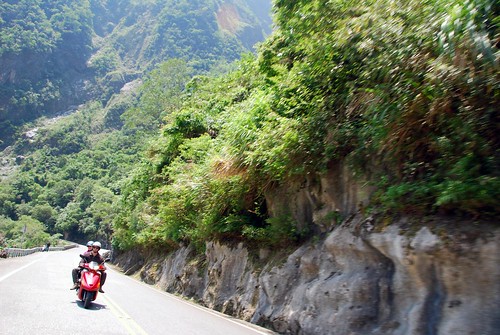
K & P scootin’ through the gorge-ous scenery.
The park’s landscape consists of mountains, gorges, rivers, and waterfalls….all great to soak up from a bike.
At one stop, we climbed up to a Buddhist temple and Japanese pagoda.
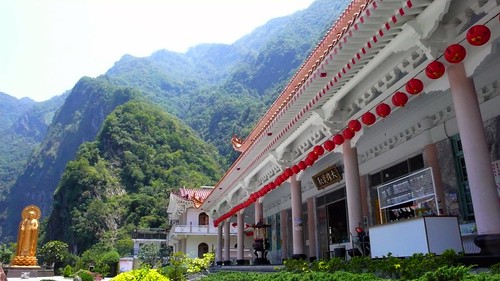
Beautiful Hsiangte Temple in Tienhsang.
And on the moderate Baiyang waterfall trail, we hiked through several long dark tunnels (perfect for practicing our “Muhahaha’s” and witch cackles!), crossed a suspension bridge…
…and, following the example of some generous tourists who passed us their rain ponchos, we took off our shoes to wade into a watery tunnel with a waterfall coming right out of the ceiling!
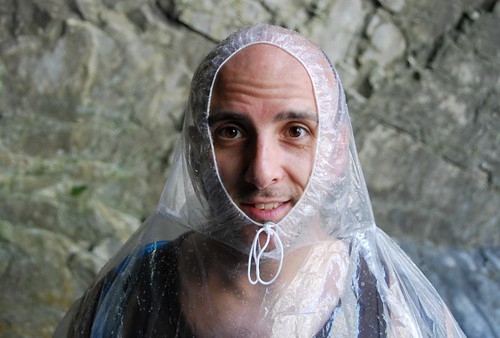
Patty, all suited up to explore the Baiyang waterfall.
Our third and final day in Hualien, we scooted to Liyu Lake where we made a valiant attempt to chew Taiwanese beetlenut (verrrry bitter, if we could have stuck with it, it’s supposed to product a nicotine-like buzz), and hiked up a mountain trail for great views.

Sorry, K, but this photo was too funny not to post! For the record, this is what I looked like too when I tried to chew betelnut.
Our trail method: the person in the front carried the Spider Stick (to knock down any stray webs across the trail), which after a slithery sighting turned into a Snake Stick, and then needed to be exchanged for an even larger branch once we encountered a largish gray monkey.
Hands down, our favorite thing about Taiwan is the people. Taiwanese people are friendly, accommodating, enthusiastic, and even the “aggressive” helpfulness is endearing. The four of us made quite a scene wherever we went because there aren’t many Caucasian travelers. Taiwan isn’t particularly affordable, especially compared to its southeast neighbors. And it’s difficult to get around if you don’t speak Chinese. (Incredible props to Hopie for navigating and guiding all four of us in and out of restaurants, shops, and public trans!) We were a sight: an extra-ordinarily tall Chinese Hope (”Sheee’s so taall!”), an even taller Jeremy, a Patrick with his shaved head, and a short curly-haired Kara. We received many stares, quite a few points and giggles, and even a few peace signs. Though remember who you’re dealing with….We go to Burning Man and dress up in costumes like it’s our jobs. So there isn’t any shame in our game. Which helps in random, awesome instances like when sweet older ladies approached our lunch table, passing out information on a political candidate. Patrick could barely get out, “I only speak English” before our table was swarmed and we were shaking hands and taking pictures with a famous Taiwanese Senator whose face we’d seen plastered on billboards.
Last week, my best friend Kara and her husband Patrick flew from New Jersey to come see us. I can’t tell you how exciting it was not only to see some familiar faces, but to be able to share this amazing travel experience with people that we love. This year-long journey is obviously a huge event in our lives, and sharing it with people who have known you for almost your whole life not only deepens our experience of the trip, but it deepens our friendship as well.
We did a lot of wandering around Taipei, and a three-day trip to Taroko Gorge (more on both of those later), but we also enjoyed a great day-trip to Jiufen. Patrick picked the spot, which was really cool because I don’t think Jeremy and I would have gone there otherwise…and it was a really cool experience! We had also planned on going to nearby Jinguashi, but kinda ran out of time in our languid wanderings. Oh well, next time!
You have to take a bus from the train station in Ruifang to get to Jiufen; it motors you up this a crazy-steep mountainside with beautiful views of the ocean. When we got off the bus in Jiufen, there was a huge commotion at a nearby temple…turns out it was some local god’s birthday and they were having a huge celebration in honor of the event.
The giant dancing heads were amusing, especially when they started doing this N-Sync era hip-hop style choreography (I’m not joking), and we plugged our ears in an effort to stop the firecrackers going off about 10 feet away from us from rupturing our eardrums. But the biggest WTF moment of the day happened when we saw a bunch of guys hitting themselves in the forehead with knives and bleeding all over their own faces. If you want to see a photo of this, click here…I won’t force those of you who are squeamish about blood to look at it.
After the excitement of the temple, we headed for the excitement of Jiufen’s Jishan Old Street, a long, narrow lane filled with snack vendors, knick-knack shops, and tea houses…and the smell of vendors frying up stinky tofu. Kara was totally appalled by the aroma…which is funny, we barely even notice it anymore! I haven’t mentioned stinky tofu on this blog yet, but it is a Taiwanese specialty snack, sold at night markets around the country. The smell is truly odoriffic; I think Kara described as smelling like “vomit after you drank orange juice.” It’s hard to imagine eating it, but one couple was chomping away on a cube of it, with their eyes watering over from the pungency.
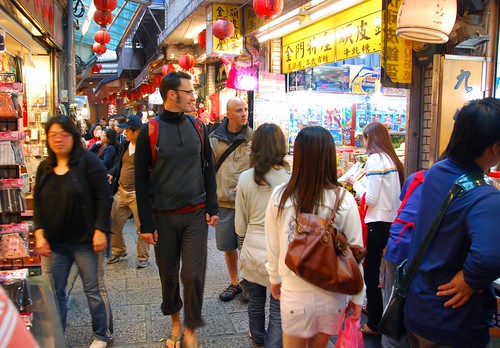
Jeremy and Patty walking down Jiufen’s Old Street.
Eventually, we made our way to the Jiufen teahouse, an absolutely gorgeous little place that fires water over hot coals and teaches you how to pour tea in the traditional Chinese way. They taught us all about warming the cups and pouring the tea from this pot to that vessel before it finally ends up in your cup.
We ended the marvelous day by heading to Jinshan on the bus and soaking in some hot springs there. We had a hot spring in mind but changed our plans when the man at the bus station suggested we check out Old Jinshan Hot Springs (http://www.warmspring.com.tw/)…once again, the aggressive Taiwanese helpfulness works to our favor!
It was an awesome day made even more fun by the excellent company. Here’s to good friends and travel! Two great tastes that taste great together!
A few weekends ago, Jeremy and I took our first big overnight trip in Taiwan to Alishan National Scenic Area. Independent travel is not a big thing in Taiwan—probably because there aren’t that many Western travelers here, and Chinese people like the ease of a tour group. So, I was a little intimidated by all the stuff we had to figure out in order to get to Alishan: where to stay, how to get there, how to book the tickets, etc. Luckily, the tourist information center at Taipei Main Station will help you with all of this…seriously, the girls there went above and beyond (remember what I said about the aggressively helpful people here?): finding a cheap hotel for us, calling to make reservations, booking our train tickets and even walking us over to the counter to pick them up. They were amazing! We couldn’t have done it without them.
Alishan is located in central Taiwan on the west coast, about 250 km south from Taipei. We took the high-speed train down to Chiayi (gateway to Alishan), which took 3.5 hours and cost NT$600 each (approx. US$18). It was incredibly comfortable, clean, and spacious, and once again, we thought: damn it’s civilized here!
There are several “must-do’s” in Alishan, and the first is to take the narrow-gauge railway (one of 3 narrow-gauge mountain railways in the world or something like that?). Tickets are NT$399 (approx. US$12) one way, and it’s a good idea to book them in advance, as they often sell out and you’ll end up standing the entire 3.5 hour ride to Alishan (which can’t be fun).
It’s funny that it took the same amount of time to get from Taipei to Chiayi as it did to get from Chiayi to Alishan, even though the latter’s distance has to be about 1/10 of the former’s. Second realization: technology is a good thing. The ride, however slow, was totally worth it, as it was incredibly scenic, passing through cloud-shrouded cedar forests and mountainsides.
When we finally arrived in Alishan, it was around 5:30pm, and already quite cold: about 12°C (54°F, though it felt much colder due to the humidity). We quickly warmed ourselves with a meal of wild boar hot pot, a specialty (along with wild deer) of this region. Despite the fact that it was only about 7:30PM when we finished, we headed straight back to the hotel to bed…the other “must-do” in Alishan is to take the 4:30AM train to Chu Shan to watch the sunrise over Taiwan’s tallest mountain, Yu Shan (almost 4000m tall). I sort of doubted our mental stability over this decision, but it turned out to be awesome. Not only is the sunrise gorgeous, but the whole “cloud ocean” phenomenon here is breathtaking. Apparently we are super lucky to have actually seen the sunrise; Jeremy’s Chinese teacher has gone twice and not seen the sunrise due to cloudy skies. I would be pretty upset if I got up at 4AM TWICE and didn’t get to see the sunrise.
There are tons of people at Chu Shan…much more than you would expect with a 4AM wake-up call, but the crowds are not annoying; in fact, it was cute—everyone was eagerly awaiting the sunrise and they even started applauding when it finally happened. Also, some people buy these polarizing glasses so they can stare directly at the sun when it finally appears over the mountains. It’s awesome.
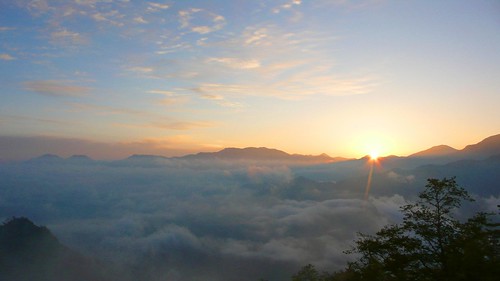
Sunrise and cloud ocean over Yu Shan, Taiwan’s tallest mountain.
Since it was still ridiculously early, we took a walk through the Alishan Forest Recreation Area, which has many beautiful HUGE ancient cedar, fir, and oak trees.
There are also some nice temples nestled amongst the giant tree forests; outside of Shouchen Temple we tried something we were calling “wild boar toffee”: they were these super-thin sheets of boar meat rolled with sesame, sugar, and nuts, and fired to a crisp. While “wild boar toffee” may not be the best marketing on our part, we promise, they were really good!
Later on in the day, we took the train back to a town called Fenqihu, a town about halfway between Alishan and Chiayi. We were glad that we only had to sit on the train for an hour, because on the way back, the diesel engine is in front of the train, spewing it’s stinky emissions straight into the passenger cars. P.U.!
Our plan was to hike from Fenqihu to Rueili, along the 10km Fen-Rui Historic Trail. We made sure to stop and grab the famous Fenqihu lunchbox, consisting of a pork cutlet and carious pickled veggies over rice. I’m not sure why the Fenqihu lunchbox is so famous…don’t get me wrong, it was really, really good and the perfect thing to bring on a hike, but most lunchboxes we’ve encountered contain the same things!
The trail navigates you through some incredible bamboo forests…I felt like we were in the middle of the movie Hero.
When we finally made it out on the Rueili side, there was a big crowd of people from one of the tour buses hanging out by the trail head. Some kids in the group saw Jeremy, the foreigner (wai guo ren), and immediately started asking him questions in English they must have learned from their schoolbooks: Do you have any brothers and sisters? How old are you? Do you like Taiwan? The little boy on the right side of Jeremy even pulled out his camera and started taking pictures of the wai guo ren!
They were very enthusiastic and they had the cutest questions. Here’s one conversation we had with the little girl on the left side of Jeremy:
Little Girl (speaking Chinese): In English, why do you say “noodles” instead of “noodle”?
Hope (also speaking Chinese): Because one strand is a noodle, and a whole bowl of them together is called “noodles.”
LG: Then why do you say “rice” and not “rices”?
Hope: That’s a really good question!
LG: Ask him (pointing at Jeremy, as if he made up the language).
And another conversation we had with the little boy who took a photo of Jeremy:
Little Boy: Ask him if he has a girlfriend.
Hope: Um, he’s my husband!
LB (amazed): REALLY?!?
H: Yes, really.
LB: How come you can speak Chinese?
H: Because my parents are Chinese.
LB: So you were born here?
H: No, I was born in the US.
LB: Then why is your hair black?
The little frowning boy on the left side of the photo was not as outgoing as his counterparts…he was so nervous around us that he would interrupt the conversation by blurting out the most random questions, like “HAVE YOU BEEN TO CARREFOUR?!?” (Carrefour is like Target/Safeway). It was kind of adorable.
After much more raucous questioning, we finally tore ourselves away and headed down the hill to Rueili, passing a mountainous landscape full of tea fields.
Even though we had had a very long day, we weren’t going to miss out on one of Rueili’s most famous attractions: fireflies! The owner of our hotel guided a group of us over to a dark path bordered by a steep hillside, and the mountain came alive with hundreds of flickering little sparkles. I obviously could not get a photo of this, but suffice to say it was magical. Growing up in New Jersey, we used to catch fireflies in little jars and it totally made me feel like a kid again seeing these magical little creatures come alive.
We HIGHLY recommend checking out Alishan if you’re ever in Taiwan. We absolutely loved it! From the incredible bamboo forests to the sparkling fireflies to the amazing tea plantations, much of Alishan felt like a little piece of magic, right in the middle of Taiwan.
Before arriving in Taiwan, I had no idea that the country was full of serious hikers. I guess I thought—like my own family—that the only hobby people from Taiwan really took seriously was eating. ![]() But it totally makes sense, this little island is blessed with a rugged coastline and a seriously mountainous interior (with several 3000m mountains!) and there are oodles of hiking trails to explore, many within day-trip distance of Taipei.
But it totally makes sense, this little island is blessed with a rugged coastline and a seriously mountainous interior (with several 3000m mountains!) and there are oodles of hiking trails to explore, many within day-trip distance of Taipei.
A few weekends back, Jeremy and I took a day trip out to the east coast of Taipei in order to hike the Cao Ling Historical Trail (căo líng gŭ dào), a 10km road (interestingly, most of the hiking trails we have encountered are actually stone-paved roads, unlike the dirt trails we have in the States) originally built in the early 1800s to provide transport from the ocean to Taipei. We started the hike in Dali and hiked to Fulong, though you could easily do it the other way around.
The train ride out there is quite beautiful…you pass through the longest tunnel in all of Asia before traveling along the rugged coastline towards Dali. This is the first time we have seen the ocean in Taiwan…weird to think that just on the other side of that blue expanse sits California (yup, Taiwan is bordered on the east side by the Pacific).
The trailhead begins right next to beautiful and elaborate Tiengong Temple (where, apparently, you can stay the night).
Early on in our hike, we acquired a four-legged friend, who stayed by our side pretty much the entire time, despite our best attempts to convince him that we weren’t going to give him any food. We even told him in two different languages!
The views of the coast were stunning as we climbed higher and higher into the mountains.
Cao Ling Historical Trail is most famous for two stone tablets that sit along the road. Both tablets were carved by an unfortunate traveler who got caught on the trail during one of Taiwan’s famous typhoons. Along the way, he carved the Chinese character for “tiger” (虎) into a rock (in Chinese mythology, the tiger is thought to control the winds), and the Tiger Tablet is now the trail’s most famous landmark.
A little while later, there is another enormous carved boulder reading, “Boldly quell the violent mists.” Poor guy, we had great weather while we were hiking, but even then it was still quite windy. I can only imagine what it must be like with a typhoon slamming into the side of the mountain!
Once you reach Fulong, you can head to the beach…there is a paid-entry area (I think it was NT$40 each, or about US$1.10), or you can walk a little further into town and access the beach for free (though the paid area is cleaner). Since we weren’t planning on hanging out at the beach for long, we just walked along the free area, but I can imagine that on a nice weekend this beach would be quite nice.
There is another really elaborate temple (I think it is Taoist? Apparently if the altar contains some fierce-looking bearded guys, then it is Taoist) on the far end of the beach in Fulong.
Taiwanese people may be serious about hiking, but there is another thing they take even more seriously (no it’s not food): hot springs! The country is full of them, and after Taiwan, I am not sure if I can face another hike if there is not a hot springs waiting for me at the end of it! From Fulong, we hopped on the train to Jiaoshi (about half an hour train ride south) to check out their public hot springs.
Jiaoshi’s public hot springs are segregated into men and women-only sections since no clothing is allowed. Entry is NT$80 each (about US$2.50), and women must wear shower caps (kind of bummer since it gets pretty hot in there).

This is actually Beitou Hot Springs (in northern Taipei), not Jiaoshi, but I thought you might like to see what a Taiwanese hot spring looks like. You can’t take photos inside Jiaoshi hot springs since everyone is, you know, naked.
A few things you should know before visiting Taiwan’s hot springs: first of all, they really put the “hot” in “hot springs.” If you dare to enter the hottest pool, be warned that the water will be scalding! You can tell by the myriad of lobster-colored Chinese men sitting around the springs.
Secondly, Taiwanese people have these funny exercises that they do in the hot springs (I think they are trying to promote blood circulation). You’ll often see these old Chinese guys doing pelvic thrusts or gyrating madly around the pools while slapping their own asses or beating themselves on the chest. It’s pretty amusing, to say the least.
Jiaoshi is also known for it’s cōng yóu bĭng (spring onion pancake). The most famous place is next door to the Jiaoshi post office; there will be a huge line out the door. Their version is deep-fried until the dough is puffy and glutinous, and you brush on your choice of three different sauces (soy, chili, and something else that tasted good) before they topped off with an egg. I don’t have a photo of this because I ate it too fast. YUM!!!
Cao Ling Historical Trail was a great outing and we recommend it if you’re ever out this way. It’s super close to Taipei (about an hour on the train) and a beautiful way to spend a nice day in Taiwan.
While most people spend their days in southern SE Asia lying around on pristine beaches, drinking fresh fruit shakes, and snorkeling in warm ocean water, the north’s main activity is trekking, usually to hill-tribe minority villages. Multi-day treks are very popular in northern Vietnam, Laos, and Thailand. We had such an amazing time on our Sapa trek, we decided to head north from Luang Prabang towards Luang Nam Tha, a small town that doesn’t seem to have much going on for it except that it makes a convenient base for exploring the nearby Nam Ha National Protected Area (NPA). LNT has been celebrated for its commitment to ecotourism principles…local tour agencies not only limit the number of trekkers in a group in order to diminish the impact on the environment, but they ensure that a large percentage of the trek fee (usually about 30%) goes towards the village, and each agency offers completely different trek routes so that money coming into the area is distributed fairly amongst the minority tribes. Sounds awesome, huh?
Well, it was and it wasn’t. From what we understand, the LNT tourism industry is still in its infancy, and there were some odd practices in place that didn’t really gel with us—namely, the pricing system. Basically, the more people that sign up for a trek, the less each individual in the group needs to pay. Basically, this means that when you sign up for a trek, you have no idea how much you will end up paying for it. You might pay US$60 each if it’s just two of you, or as little as US$25 each if 6 more people sign up after you. It’s really frustrating.
What ends up happening is that people searching for treks wander around from agency to agency, looking for a trek that already has other people signed up. And since LNT is not super heavily touristed, everyone waits and waits until another person or couple signs up before they sign up, in order to ensure that they will not pay top dollar for their tour.
So, we waited all day hoping that another person or couple would sign up for a two-day tour. At 7PM, when no one had signed up yet, we finally gave up and booked a tour. BUT, because it would have been really expensive (like US$75 each) for a two-day trek (since it was only the two of us), we decided just to do a day hike. In retrospect, we should have signed up EARLIER in the day rather than later, so that other people playing the same waiting game might have signed on to our trek.
Annoying, dontcha think?
We met our tour guide Noo (pronounced “no-oh”) in the morning, and she was very shy. Laotians in general are very reserved, extremely polite people (which is VERY different from the rest of SE Asia). Our first stop was the local market, where (we found out later) Noo was picking up our lunch.
We were absolutely amazed by the market…it was clean, organized, quiet, and odor-free; quite an enormous change from the other markets we had been to in SE Asia. I mean, the produce was all organized into little piles! The butcher area had all the assorted animal parts, but there was not even a hint of smell! Even the dirt floor looked swept-clean somehow.
Even weirder: as I was wandering around the market, I saw a family selling bamboo shoots…and some small (dead) songbirds, a mouse, and what looked like a ferret or long squirrel. I took a photo and the family quickly covered the dead animals up under palm leaves (If you want to see the photo, click here, I won’t post it in case someone out there is squeamish about seeing a dead ferret/squirrel thingy). I thought maybe they had hunted these animals illegally, but Noo thought they were just embarrassed. We have seen some really, really weird stuff for sale in SE Asia markets (remember the “ba”?) and nobody has ever tried to hide anything from our cameras. This was like a Bizarro market!
After the market, we headed out to a local village to start our trek. The drive was stunning…a gorgeous landscape of rice paddies studded with bamboo shacks.
We walked through a dusty village and headed into a dusty forest. Little did we know that the great majority of our hike would be within this dense cover. I mean, isn’t the point of a hike to see stuff? Noo did point out local fruits and bird feathers and that sort of thing, but we didn’t see much for several hours except dusty trail and trees. When we did get to a clearing, the smoke was so thick from the local slash-and-burn agriculture that we couldn’t see very far anyway.
At some point, Noo told us it was lunch time and she ran off into the forest. We were sitting there wondering what she was doing when she came back with a handful of palm leaves, which would become our lunch table.

Our lunch spread of roasted duck, bamboo shoots, river weed (I wasn’t crazy about this), and sticky rice.
Finally, we were out of the forest and descending into a village. Now we’re talking!
We saw a little cutie helping her family de-kernel some corn.
The village was small and it only took us about 10 minutes to walk through it on our way to the local waterfall. The waterfall was cool…there were dozens of tiers ending in small pools where you could go for a swim. Noo led us all the way up to what seemed like the very furthest pool (which is good, the water is cleaner upriver). The water was really cold, so I did my usual thing of getting in really, really slowly (I know it hurts more that way, but I can’t help it). Noo surprised both me and Jeremy by yelling, “Here, let me help you!” and splashing me! This quiet, reserved girl who had said maybe 3 words on her own the entire trek was now showering me with cold water! Well, it worked, I finally got in. ![]()
So, that was out experience in Luang Nam Tha. I don’t really feel like we saw much and we kinda paid a lot for it (our day trip was US$37 each, I think…for reference, we paid US$23 for two days in Sapa). Noo was sweet but she ain’t no Thuyen. ![]() I’m kinda glad that we didn’t end up doing a 2-day trek because I’m not sure if the scenery would have been much better. Jeremy and I both think the 2- and 3-day trekking trails probably just meander through more dusty forest (though you would get to stay in a village for the night).
I’m kinda glad that we didn’t end up doing a 2-day trek because I’m not sure if the scenery would have been much better. Jeremy and I both think the 2- and 3-day trekking trails probably just meander through more dusty forest (though you would get to stay in a village for the night).
I guess the lesson here is, if you ever go to LNT:
1. Sign up early in the day for the trek YOU want; someone else will probably follow.
2. Don’t go during burning season.
I think you could safely say that our experience in LNT was kind of a bust. We really admire the commitment to sustainable and fair tourism here, but let’s just hope they work out the kinks so that people who make the effort to get out to LNT can spread the word.
Somewhere around Hanoi, we made the hard decision to skip diving in Sipidan (we had been planning on ending our tour of SE Asia by diving in eastern Malaysian Borneo, reportedly one of the best scuba sites in the world right now). On the one hand, we really, really want to dive here before it gets polluted/overvisited/crowded and the animal and plant life starts to die off. On the other hand, with flights, accommodation, and diving, it will cost us over US$1000 to dive for 3 days here. Not only would that really strain our budget, but we’re currently spending that much every 2 weeks or more in SE Asia. So…two weeks of experiences or three days? It’s always a trade-off while you’re traveling (as you’ll hear many backpackers lament)—an extra day Here means you won’t see There; an airplane ride There means you miss the opportunity to hop off the bus Here.
On the plus side, NOT diving Sipidan meant we could push back our leave date and travel a little more leisurely through the rest of SE Asia, which is really, really luxurious. As it is, we are traveling much more slowly than many backpackers around here, who move from place to place every 2 days or so. I understand that—the hunger for new experiences and the fear of missing out—and I feel it tugging at me every so often, but I think Jeremy and I have found a healthy balance between wandering and staying still here in SE Asia, and it feels good to have the luxury to move slowly now that we don’t have the pressure of getting to Sipidan by a certain date.
One opportunity that opened up as a result of cutting Sipidan was Sapa. Sapa is a small town in the mountains northwest of Hanoi, near the China/Vietnam border. It is famous for its wealth of ethnic tribes that live there, and most people do a one-, two-, or three-day trek in the mountains through various villages. The only way to visit Sapa is to take a 9-hour overnight train there, which turned out to be quite pleasant! Private companies purchase and maintain certain cars on the train, so if you buy a “soft-sleeper” class ticket (about US$25 or so), you spend the night in a clean, comfortable car with 4 beds (2 bunks). The only downside is that you arrive in Sapa at 5AM, which is painful any which way you look at it.
When we arrived it Sapa, it was very foggy (it would stay that way the entire time we were there), and coupled with our grogginess, I felt like we were in a dream…a dream that had us walking through a National Geographic. There are tribal people everywhere around town dressed up in their finest clothes to sell stuff to tourists. Clothing differs based on the tribe, but many men wear long petticoats over indigo-dyed pants and tunic, while women accessorize with brightly-colored headscarves, woven tapestries, and silver accessories.
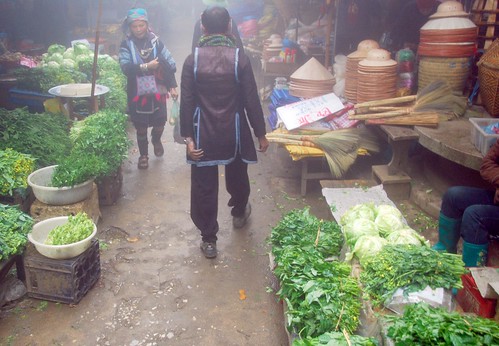
Walking through the market in Sapa.
We spent our first day in Sapa wandering around local Cat Cat village (a short hike from town but not very scenic), and looking for a trekking tour. Like Halong Bay, you can book a tour of Sapa in Hanoi, but it is pretty easy to travel independently to Sapa and you’ll save money booking a tour in town vs. in Hanoi. Most overnight tours include a village homestay, and after our experience in Vinh Long, we were worried about having a disappointing, “manufactured” experience if we opted to go that direction. So, at first, we were planning on just doing a day hike, especially since it was my 32nd birthday the next day. But after talking to a couple of different tour agencies, we decided on a two-day trek that would begin in Ta Van village and end with a homestay in Ban Ho village (mostly because Ban Ho village is at a much lower elevation than Sapa, which would allow us to get below the thick fog and actually see some of the countryside, but also because Ban Ho is further away from Sapa, and we thought that might mean there were fewer tourists). Though it would be lovely to spend my birthday with Jeremy, eating a nice meal and sleeping in a comfortable bed, I figured, hey, you only turn 32 once…why not spend it with a hill tribe family in the Vietnamese mountains? ![]()
We are really, really glad we chose to go this route because it ended up as one of the best experiences we’ve had on our trip so far. Even better, we booked our tour through our hotel (Lotus Hotel, where we had an incredible room for only US$6), and it only cost US$23 each (we would find out through some of our fellow trekkies—who did quite a bit of shopping around—that this was one of the cheapest tours around Sapa).
We were picked up in the morning by our tour guide, Thuyen (a spunky, 22-year-old Vietnamese girl who did the entire 18km hike in plastic galoshes), and we met the rest of our crew in the van that would take us to Ta Van. There were 6 of us in total: two German girls (Katrin and Gesina), a German guy (Ben), and an English girl (Jo).
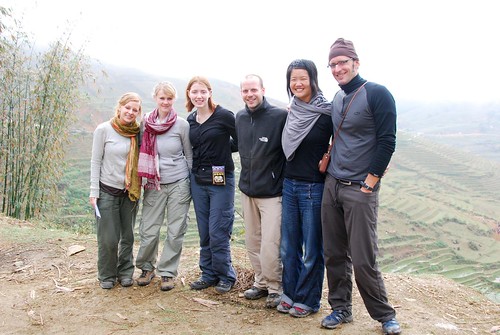
The crew: Katrin, Gesina, Jo, Ben, me, and J. For some reason, we look enormous in this photo.
As soon as you leave Sapa town, you begin to see those famous rice terraces that this part of the country is known for (well, maybe you can actually see them in Sapa but it was too foggy for us to see anything in town). It is absolutely incredible how these people have transformed the mountains—it reminded me of some of the best earthworks or Goldsworthy-esque feats of environmental manipulation.
We arrived in Ta Van and were immediately swarmed by Hmong (the name of the local tribe) ladies upon exiting the van. We didn’t really know what was going on, but they had decided that they would be our entourage on this trek, and followed us closely the entire hike through Ta Van village.
The ground was incredibly muddy and slippery due to heavy rains the previous night, and early on in the trek, I slipped and fell. I wasn’t hurt at all, but the locals are so steady on their feet around this terrain that falling is unheard of, so throughout the rest of our hike in Ta Van, I became The Falling Girl…whenever we approached some tricky or steep part of the trail, two Hmong women grabbed my hands and practically pushed or dragged me up the hill (they are surprisingly strong). This must have been a funny sight, as they are so tiny that I am practically twice their size. To add insult to (non-)injury, they are all wearing plastic sandals and galoshes (while we are in our fancy outdoor hiking hoes). Honestly, I didn’t really need their help, but still, I was grateful at some points to have someone to hold on to!
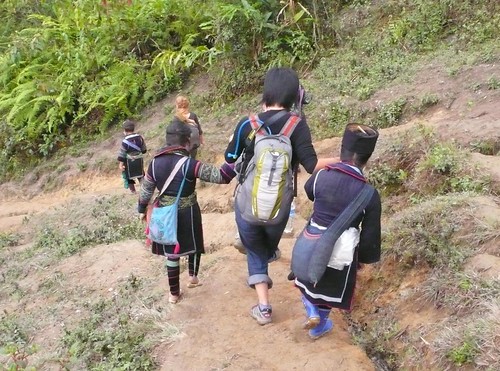
Two Hmong ladies helping The Falling Girl.
The countryside was absolutely gorgeous. We loved seeing how people live in this village, huts set amongst rice terraces.
We finished our hike through Ta Van at a waterfall, and that’s when we finally figured out why we acquired an entourage. Out came the various tourist trinkets and knick knacks that were previously hidden underneath the folds of their clothes and in their basket backpacks. I really wanted to buy something to thank these ladies for all their help and company through the hike, but I just didn’t like anything and didn’t want it to take up space in my already heavy backpack. Ben had given one of the women 20,000 Vietnamese dong (VND), the equivalent of about US$1.15. He told her, “I don’t want anything, but I don’t want you to try to sell me anything either.” So, we tried doing this as well…Jeremy gave one woman 20,000 VND and I gave each of the women who helped me 10,000 dong, but they begged for more. I would have given them more but the only bills we had were very large, like 200,000 VND (approx. US$23.50, which is a fortune around here). Note to self: next time you’re in the Vietnamese mountains hiking with a bunch of Hmong hill tribe ladies, remember to bring small bills.
It was an uncomfortable and sad experience there near the waterfall…these women had walked the entire distance of the village with us on the small hope that maybe we would feel bad enough to buy something from them. I wished that they had something I liked. I wished that we had brought smaller bills. I wished that they knew how to make things that were more useful to trekkers (rather than wind pipes and small, woven purses). I wished that in their tribe, the people went to school so that they didn’t have to rely on selling stuff to tourists. It is a sad but true state of affairs here in Sapa.
We spent the rest of our hike getting to know the rest of our trekkers and Thuyen, and asking her lots questions that she couldn’t answer (what she lacked in English skills, she made up for in enthusiasm). We never acquired another entourage, which suited us just fine, because we encountered lots of people on the road to Ban Ho, and waved at little kids running loose in the countryside.
Finally, we started descending into the valley that holds Ban Ho village.
We arrived at our homestay, where a small homemade sign told us that this was Mr. Ma A. Hu’s home, which offered “Homestay, Food & Drinks, and Cultural Show”. Again, our Vinh Long doubts came rushing back…we were worried that we were going to have to sit through some uncomfortable display of Vietnamese ethnicity, especially since Thuyen kept talking about the “singing and dancing” that lay ahead in the evening.
The house, like most rural homes in SE Asia, is made of bamboo and built on stilts. You walk upstairs and enter a large room, which has several smaller “rooms” branching off it. This is when we got our first indication that our homestay experience here wasn’t going to be like the one we had in Vinh Long. Right as you walk into the house, there was a small altar with candles, a medium-sized slaughtered pig (with incense sticks in his mouth) and 4 chickens that looked as if they had been plucked and immediately dunked straight into boiling water—with their heads and feet still attached. It turns out that someone in the family is sick and some local elderly women were invited to the home to conduct a good luck ceremony for the family (we were not allowed to take photos of this), but it was quite a sight…we weren’t really expecting to see any slaughtered animals, much less inside the home, about 20 feet from where we were to sleep.
Jeremy and I slept in one room and the other 4 trekkers in another.
After chilling for a while at the house (we were pretty tired after walking 18km!), we headed off to the local hot (actually, warm) spring for a quick soak. Most homes do not have hot water in Ban Ho so this is the place where most locals bathe. Men and women sit in different pools…women go into an enclosed hut (shown on the left in the photo below), while men get two huge pools with the nice outdoor view.
After we got back to the house, Thuyen went into the kitchen to cook our dinner. Many more people had congregated at the house, and as usual, we were in the dark as to what was going on…we just sat back and enjoyed the company.

We don’t know who this lady was, but she lived at the house (maybe Mrs. Hu’s sister?). Her baby was adorable, and already knew how to wave and say, “bye bye!”. By the way, if you’re wondering what the mark on her forehead is, many of the local tribes near Sapa practice Chinese medicine. The mark is from a cupping-type procedure in which a buffalo horn is heated and placed on the forehead.
Soon, dinner was served. It was quite a feast! There was waaaay too much food for all of us, but we did our best. Mr. Hu and his eldest son sat with us at the table, each of them holding a 1.5L Aquafina bottle. When they brought out the shot glasses, we realized the bottles were filled with their homemade rice wine (not water). We also realized that Mr. Hu and his son were on a mission. A mission to get us drunk. Seriously, they did not stop pouring the entire night. We were taught how to say “cheers” in Vietnamese: “mo, ta, bai…YO!!!,” a phrase that Thuyen gleefully yelled with much conviction every 3 minutes or so as they refilled our shot glasses (again).
In the middle of dinner, Thuyen ran off into the woods somewhere (Ben was theorizing that she had a boyfriend in the village, but we were skeptical). Just as we were starting to come up with more and more elaborate theories (in our drunken state), Thuyen returned…she had run into the mountains to pick me flowers for my birthday (and somehow found a little plastic clock as a birthday gift). It was an incredibly sweet and thoughtful gesture, and everyone was commenting on how she had gone above and beyond a tour guide’s duties. I think it was around that time that she started calling me her “sister.” ![]()
This photo captures the spirit of that night very well: chaos, shot glasses in the face, and new friendships.
Suddenly, it was a PARTY! Thuyen announced that it was time for the dancing, and we were bracing ourselves for a bunch of people being paraded out in their “traditional” costumes. Instead, quite unexpectedly, our homestay family popped in a video of some thumping Asian disco featuring a scantily-clad go-go dancer gyrating to techno music. This was our “cultural show.” ![]()
The rest of the night starts to get a bit fuzzy…we played camera tag with all the adorable kids running around (they would hide as our flashes went off), Thuyen and I danced to techno music, we threw back about a million more shots with Mr. Hu and his son, and at some point we were invited to the big room in the main house for “second dinner.” We didn’t understand what was happening at the time, but after a while we figured out that many members of the village were invited to the Hu’s house to share in the slaughtered pig and the four chickens that were sacrificed in the good luck ceremony.
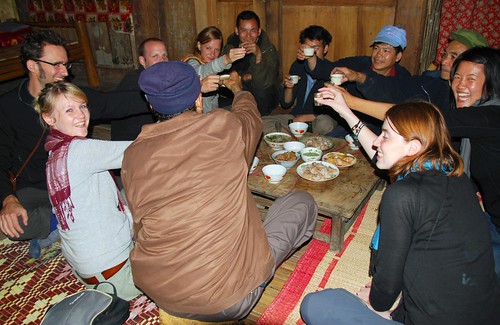
Taking yet another shot of rice wine.
Needless to say, we had an incredible time. Jeremy was very concerned with Sapa being too much of a “human zoo,” but this experience erased any doubts from our minds…instead of some contrived ethnic show, our homestay family showed us what they were really into: traditional animist blessing ceremonies set against the backdrop of club dancers grinding their hips to loud, cheesy techno. We were fascinated by the clash of old and new cultures and appreciated the fact that they didn’t adhere to tradition just for our sake.
When we woke up the next morning, I was (surprisingly) feeling fine, but the others were quite hung over. We had a slow morning, wandering around the village to a waterfall, and then returning to Mr. Hu’s house for lunch before we headed uphill back to Su Pan village to get picked up.
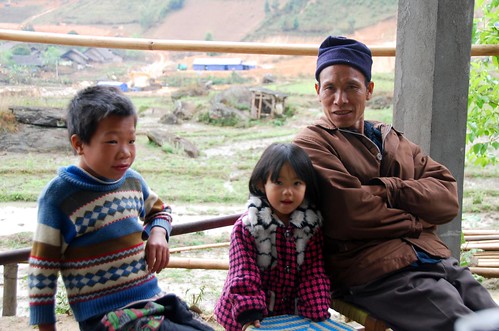
Mr. Hu with…his grandkids? We never could decifer how (or even if) they were related.
I am so glad we didn’t opt to stay behind in Sapa to have a nice dinner and sleep in a comfortable bed. I am so glad that we were rewarded with this amazingly memorable experience after opting to skip out on another one (Sipidan). This was definitely one of the most special birthdays I’ve ever had…thanks birthday fairy! It’s gonna be a good year.
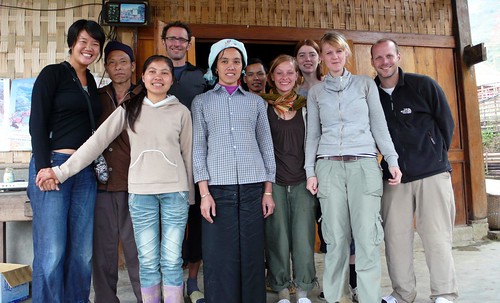
One big happy family (how cute is it that Thuyen wanted to hold my hand for the photo?!?).
More scenes from our trek:
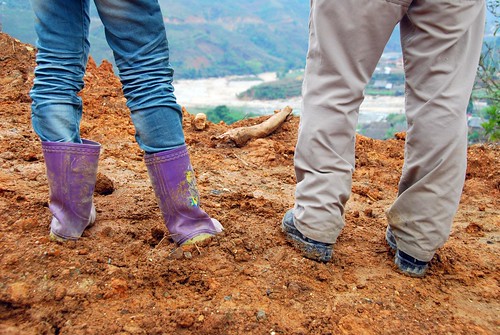
Thuyen’s plastic galoshes and Ben’s German hiking boots in the mud.
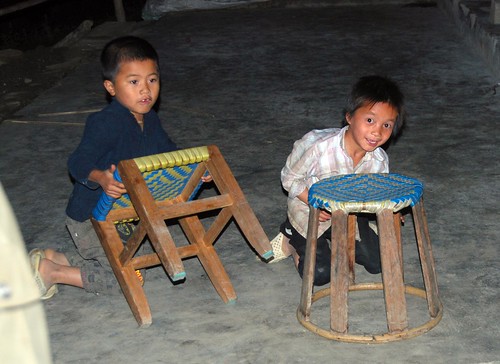
Playing camera tag with the kids.
Starting in Australia, the country we heard the most negative commentary about was Vietnam. Many travelers we encountered just didn’t seem to like the place, and perhaps the people who did like it just weren’t as vocal. Plus, the Lonely Planet is filled with warnings about scams, thieves, and pickpockets in the country, so we were understandably being a bit more cautious when we entered the country.
If there is one thing we have learned from traveling SE Asia, it’s to expect the unexpected. I can tell you after spending almost three weeks in the country so far (sorry, I’m a little behind on the postings!) that we absolutely love it. We find the people incredibly warm, friendly, open, and curious. It is perhaps our favorite country in SE Asia so far (though we haven’t been to Laos or northern Thailand yet). And all those warnings about crime and scams? Well, all prices are negotiable in Vietnam and it’s true that most vendors and cab drivers will try to get the most out of you that they can. But pickpocketing? We haven’t had any problems whatsoever with that. Maybe we’re just lucky, but we really haven’t seen what all the fuss is about.
Anyway, I’m getting a bit off topic here. My point was that the Vietnamese people are just incredible. From the moment we crossed the border, we had kids and adults alike falling over themselves, waving at us furiously and yelling, “Hallo!!! Hallo!!!” So when I read that you can arrange to do a homestay in the Mekong Delta town of Vinh Long, I had this whole elaborate fantasy of staying in a rustic riverside home with a large, loud, and loving Vietnamese family. Maybe Jeremy and I would help them cook dinner and we’d eat together, trying to communicate via pantomime or the limited English they knew (because we sure as heck don’t know much Vietnamese). Perhaps we’d drink some rice wine before heading to bed, where Jeremy and I would sleep in a back room on straw mats amongst wandering chickens and ducks. We’d wake up a the crack of dawn when the roosters start crowing and help the family make breakfast before we headed back to Saigon on the bus. So when we arrived in Vinh Long (just a short bus ride over from Can Tho), we eagerly signed up for a homestay and took a boat over to the house.
Yeah, not so much.
The surprises started as soon as we stepped off the boat. First of all, Vinh Long is rural, but it’s definitely not the deep countryside. There are large and rather elaborate-looking concrete houses mixed it with more simple wooden shacks. Our homestay was actually a large property with a front house (where the family lived), a large outdoor dining area, and a row of connected bungalows, where the guests stay. The bathrooms and showers were in a separate building…they even had western toilets! So much for my rural fantasy. ![]()
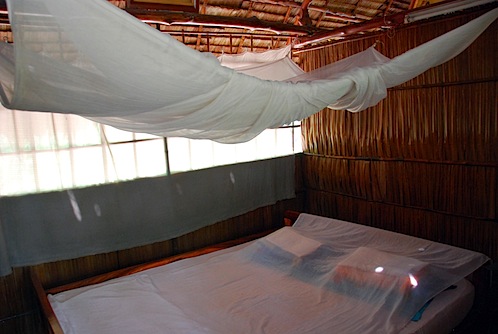
Our bungalow.
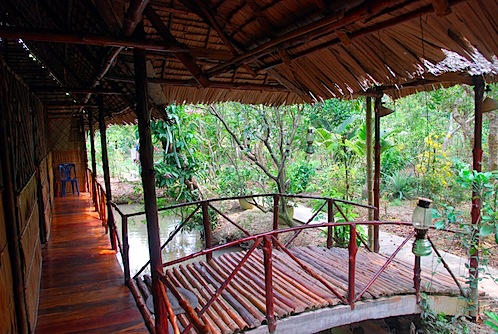
The bridge over to the rooms; the bungalows were built over a fish pond. All night long, we heard “galoop, galoop,” as the fish surfaced to eat the mosquitos on the water’s surface. Jeremy described this as “the circle of life: the mosquitos eat us and the fish eat them, then we eat the fish.” This kinda grossed me out, actually.
So you’re not exactly living or eating with a Vietnamese family, and the place is more like a bed and breakfast. You have little interaction with the family other than when they serve the meals. We thought perhaps we had just gone to a more touristy homestay, but other travelers that we met later had the same experience (at a different homestay). Also, we thought it was quite expensive (US$15 per person, not including the boat ride over).
Even though the actual homestay experience was not what we expected, we still had a really nice time exploring the neighboring town. Our homestay had free use of bikes, so we went for a ride around the village. It was pretty hot and we were in full-body sweat two minutes after we started riding, but it was so much fun to ride around and see some of the homes in the neighborhood. We couldn’t ride more than two minutes before running into local people shouting and waving at us (especially the kids).
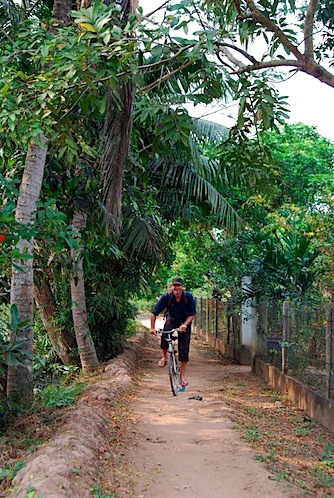
We took a little breather back at the homestay, hanging out in the hammocks for a few hours to cool off before dinner.
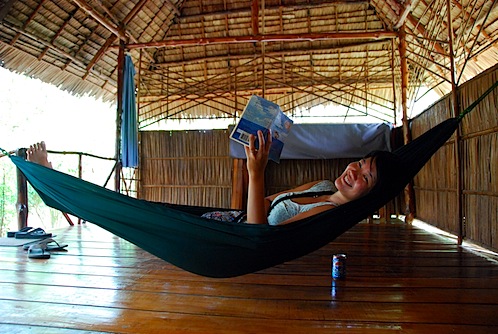
We went for a walk right at sunset and were again rewarded by super friendly people all around town. This little guy was so excited when we saw Jeremy, he tried to climb him!
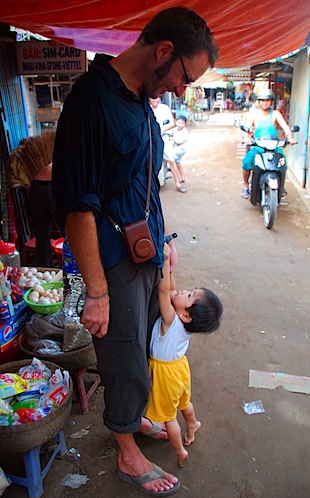
So the homestay wasn’t exactly what we expected, but we still had a nice enough time and it was fun to see a more rural part of the Mekong (as opposed to Can Tho). Maybe next time I’ll try to keep my imagination in check. ![]()
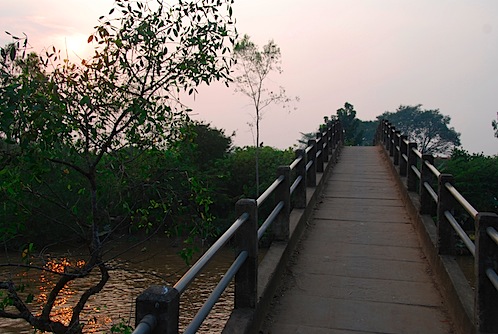
The bridge to the next island.
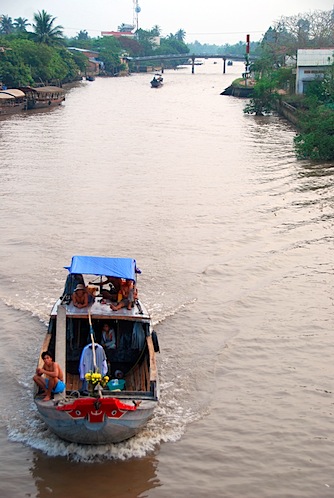
The mighty Mekong.
One of the (many) really wonderful things about traveling for an extended period of time is the freedom you have in your decision-making process. I think this is one of the main differences between vacationing vs. traveling…on a vacation, you have a limited period of time and it usually benefits you to make plans as to what places, sites, and cities you are going to visit in order to fit it all in. On the other hand, traveling provides you with the luxury of listening to your gut. Don’t like a place? Leave. Really like a place? Stay a day or two longer until you feel restless again.
It was this very gut feeling that told us to cross over from Cambodia into Vietnam via a boat down the Mekong. We hadn’t really met any other travelers in Cambodia that had done this, but the travel books made it sound cool so we decided to go for it. Our final destination was Can Tho, a smallish town situated along the Mekong and famous for its floating markets. This would prove to be somewhat more involved travel day, as there weren’t really direct boats from Phnom Penh to Can Tho. Rather, we took a van to a slow boat, which stopped at the Cambodia/Vietnam border so we could process our passports, then hopped on a fast boat to Chau Doc, on the Vietnam side. While we were zooming down the Mekong, one of the guys on the boat asked us if we wanted to take a van from Chau Doc over to Can Tho for US$8. We were a bit worried that he was overcharging us since you usually pay a premium for convenience like this in SE Asia. So we told him we would find our own way to the bus station and figure it out. When we landed at Chau Doc, we climbed out of the boat, put our packs on and asked for directions to the bus station. Surprise, Hope and Jeremy! The bus station is on the other side of the river. I have no idea if there is any logic behind dropping you off on the wrong side of the river other than to make you more likely to buy a ticket from this guy’s company. Without any other real choices (other than swimming), we hopped back on a longtail boat across the river, where we were loaded onto some two-wheeled bicycle-drawn carts (known as xe loi and apparently unique to the Mekong Delta), and ended up at the bus station, where we boarded another van towards Can Tho. For the record, that’s: 3 boats, 2 vans, and a xe loi to get from Cambodia over to Vietnam. Here’s Jeremy in his xe loi:
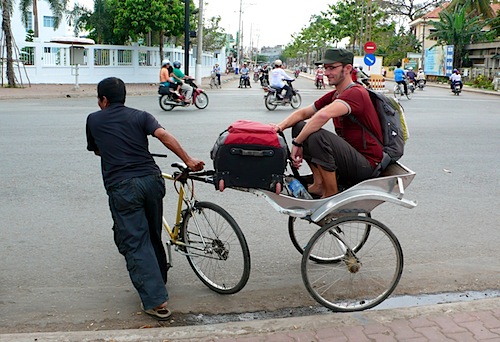
I am not sure why, but for some reason we keep irrationally expecting the countries in SE Asia to be more similar to each other than they actually are. Perhaps it is because we’ve met a lot of people who have traveled the entire region (as we are doing now) and so we tend to lump all the countries together under the term “Southeast Asia.” The countries are, in fact, completely different, despite the fact that the terrain often looks the same. Here we are, floating along the Mekong, and boom—as soon as you cross the border into Vietnam, suddenly all the houses are on stilts and the people are wearing “rice picker” hats. By the way, I totally thought this was a Vietnamese stereotype, but the people here really do wear these hats! And it’s not just one person here and there, but almost every woman (men do not seem to wear them) in the countryside seems to be wearing these cone-shaped toppers. Interestingly, women also wear these brightly colored and patterned pajama-esque Lycra pantsuits.
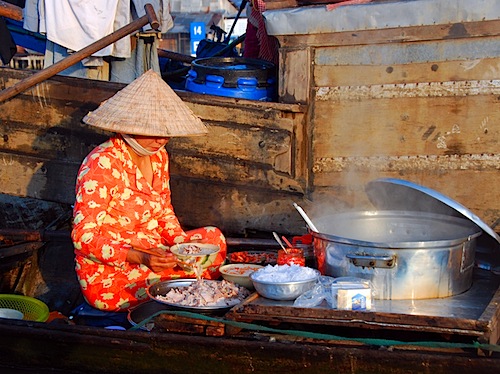
Jook vendor at the Cai Rang floating market near Can Tho.
The main reason why people visit Can Tho is to visit the floating markets nearby in the Mekong. We met a super cute Dutch couple (Joachim and Rianne) on the trip over from Cambodia, and we decided to look for a floating market tour together. You can book these tours through the Can Tho Tourist office but you will end up on a large boat that is not able to navigate the small canals that wind their way through the countryside and drain into the Mekong. Plus, if you book a tour directly with one of the locals, the money goes directly towards feeding their family.
In order to book a tour, you simply stand around on the main road where the boats dock and within minutes, a local Vietnamese lady will inevitably approach you about a day tour. That’s how we met Phuong, an incredible Vietnamese lady with the most amazing laugh. We tried to negotiate with her for the price of our boat tour, but she wouldn’t budge from US$50 for all 4 of us. But we thought she was so sweet and cute we just let it slide. What’s a few bucks when you really enjoy the company?
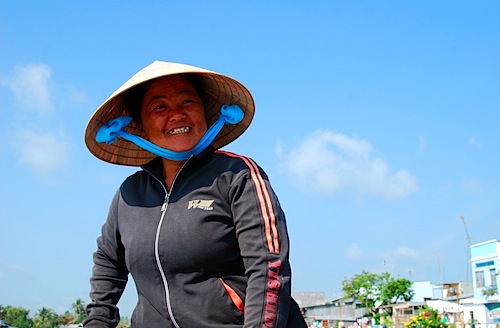
Phreaking phenomenal Phuong.
Because the floating markets are busiest early in the morning, Phuong picked us up at the ungodly hour of 5:30AM. We got to see the sunrise over the Mekong, which was not a bad way to spend our first morning in Vietnam.
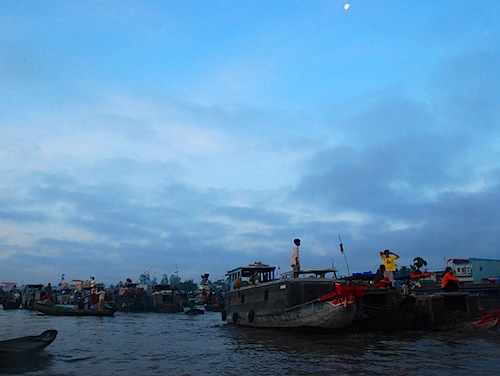
Our plan was to visit two different floating markets: Cai Rang, which is a larger market but more heavily touristed, and Phong Dien, which is famous because the people who vend and shop there do not use motors, but paddle their boats instead. Most of the people who take part in these markets are not buying for themselves, but for vegetable markets and restaurants, i.e., they are buying in bulk. Still, I wonder if they think it is strange that a bunch of tourists pay money to see them do their grocery shopping?
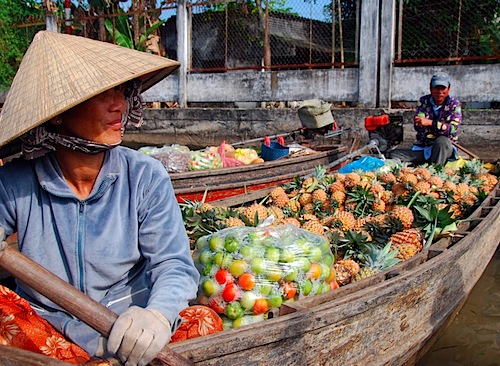
Pineapple vendor at the Phong Dien floating market.
So that buyers can easily tell what a boat is selling, vendors hang their wares on a long pole sticking straight up out of the boat. This guy was like the Costco of Cai Rang!:
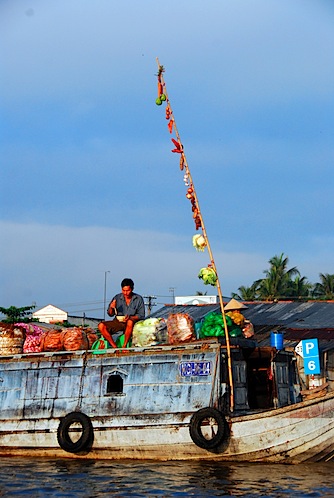
Also cool to note: the boats on the Mekong are painted with circular eyes (we would find out later that boats along the Red River up north are painted with slanted eyes). Does anyone know why this is the case?
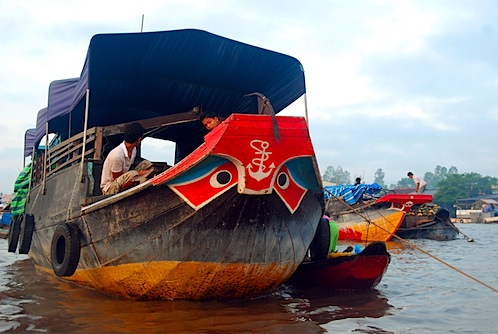
To be quite honest, we were a little disappointed with the actual markets…I guess we thought they would be bigger. In fact, they are quite small, in particular Phong Dien, which was basically a collection of about 20 boats bumping into each other as people did business. But it really didn’t matter, we had so much fun on the boat with Joachim, Rianne and Phuong that the actual sights seemed almost inconsequential. We basically meandered around the Mekong, chatting and laughing and getting to know each other. by the way, Phuong also brought her teenage son on the boat, but he didn’t talk much (I think he doesn’t speak English).
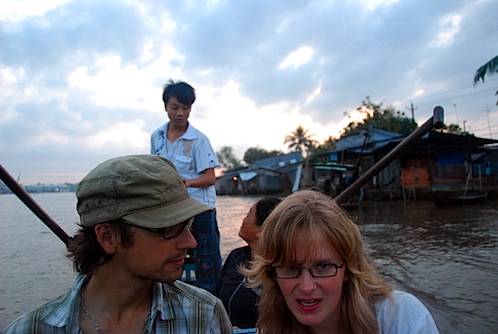
Joachim and Rianne, with Phuong’s son in the background.
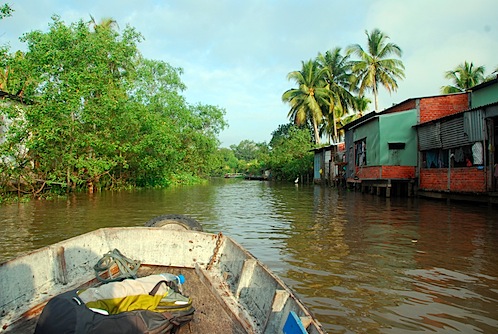
In addition to seeing the markets and the small canals, Phuong also brought us to a rice noodle “factory.” It was really interesting! Now we totally know how to make rice noodles.
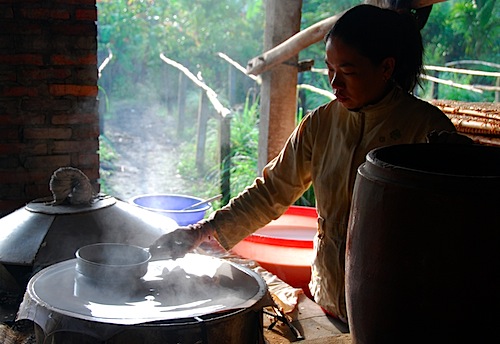
And, we got to see a bunch of the countryside, where Phuong picked a bunch of random fruits for us to taste, and we got to see those famous Vietnamese rice paddies.
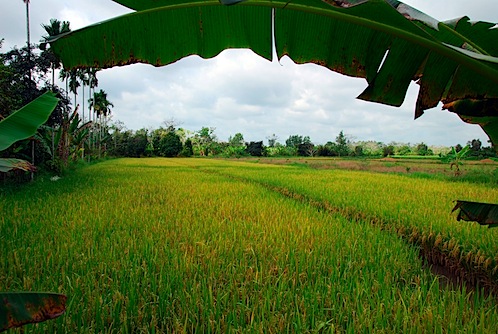
Phuong was really excited to show us something she called “the moneky bridge.” She took us to what was essentially a pole with a handrail stretched across the river and I started to walk across it when she literally yanked me back and told Jeremy to go first. I figured it was a precarious crossing so she wanted a guy to go first. As Jeremy was halfway over the bridge, she started giggling like crazy…”Look! Now there’s one monkey on the bridge!!!” She REALLY cracked herself up, and Jeremy was totally confused, like “am I supposed to cross this thing or not?” Which made the entire episode incredibly amusing to me. ![]()
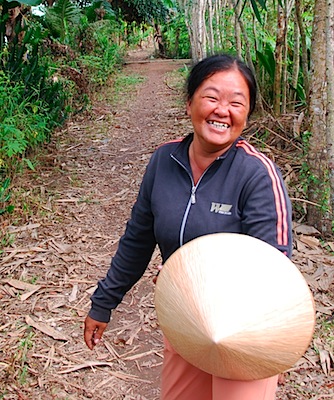
Phuong, unable to contain herself.
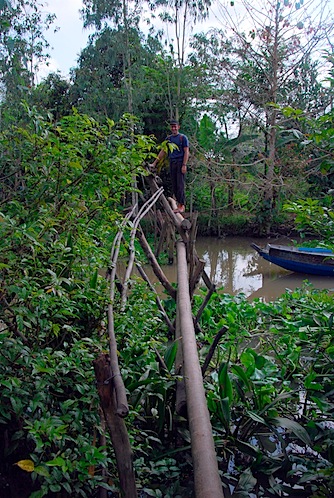
Jeremy, the monkey on the bridge.
We ended the tour by stopping for lunch at a nice place along the river, where Joachim and I played with snakes.
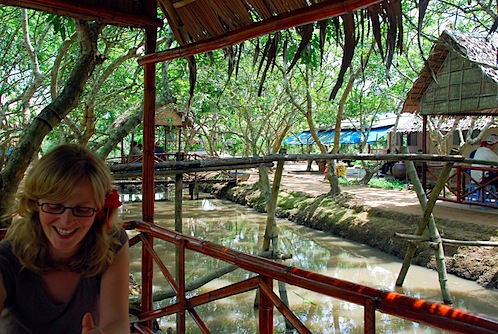
Rianne at our lunch spot along the Mekong.
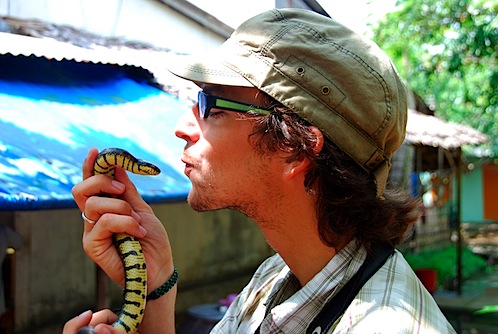
Joachim, getting fresh.
We had an awesome time in Can Tho! This was one case where the whole experience was definitely a lot greater than the sum of its tourist sites. Thanks to the cutest Dutch couple we’ve ever met (Joachim and Rianne, that’s you) and Phuong for making our stay in Can Tho so memorable. And thanks, gut feeling, for steering us right.
P.S. As a final shout-out to Phuong, this is the contact information listed on the card she gave us (I believe the phone number and email address are her brother’s): 0913 618 056, triet_quang@hotmail.com.

